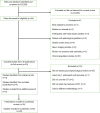Sweating the small stuff: A meta-analysis of skin conductance on the Iowa gambling task
- PMID: 31493212
- PMCID: PMC6785590
- DOI: 10.3758/s13415-019-00744-w
Sweating the small stuff: A meta-analysis of skin conductance on the Iowa gambling task
Abstract
To systematically examine the role of anticipatory skin conductance responses (aSCRs) in predicting Iowa Gambling Task (IGT) performance. Secondly, to assess the quality of aSCR evidence for the Somatic Marker Hypothesis (SMH) during the IGT. Finally, to evaluate the reliability of current psychophysiological measurements on the IGT. Electronic databases, journals and reference lists were examined for inclusion. Data were extracted by two reviewers and validated by another reviewer, using a standardised extraction sheet along with a quality assessment. Two meta-analyses of aSCR measures were conducted to test the relationship between overall aSCR and IGT performance, and differences in aSCR between advantageous and disadvantageous decks. Twenty studies were included in this review. Quality assessment revealed that five studies did not measure anticipatory responses, and few stated they followed standard IGT and/or psychophysiological procedures. The first meta-analysis of 15 studies revealed a significant, small-to-medium relationship between aSCR and IGT performance (r= .22). The second meta-analysis of eight studies revealed a significant, small difference in aSCR between the advantageous and disadvantageous decks (r= .10); however, publication bias is likely to be an issue. Meta-analyses revealed aSCR evidence supporting the SMH. However, inconsistencies in the IGT and psychophysiological methods, along with publication bias, cast doubt on these effects. It is recommended that future tests of the SMH use a range of psychophysiological measures, a standardised IGT protocol, and discriminate between advantageous and disadvantageous decks.
Keywords: Decision-making; Emotion; Reward.
Figures





References
Publication types
MeSH terms
LinkOut - more resources
Full Text Sources
Miscellaneous

